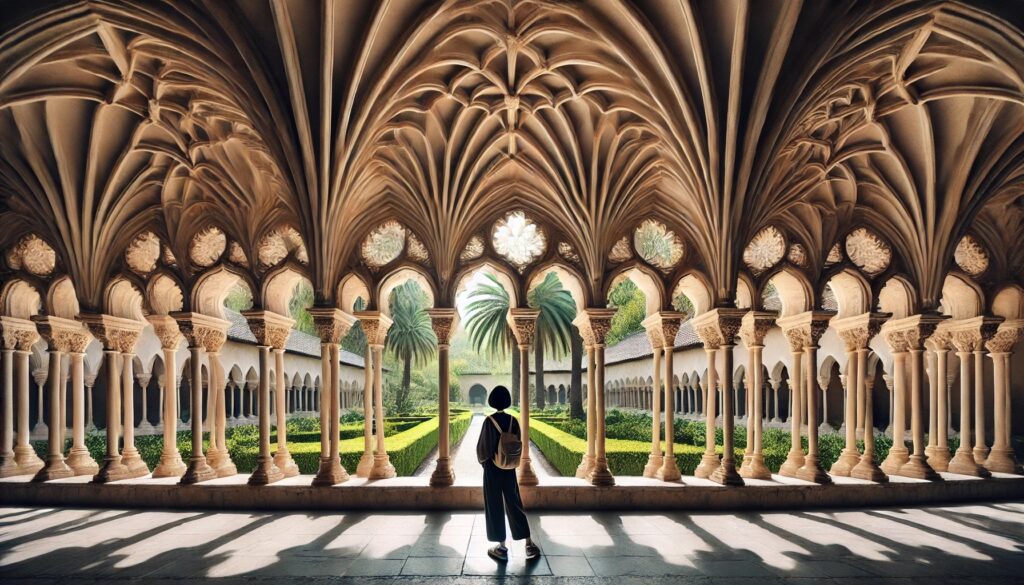ChatGPT:
Amalfi is a picturesque coastal town located in the province of Salerno, within the Campania region of southern Italy. Nestled along the renowned Amalfi Coast (Costiera Amalfitana), a UNESCO World Heritage Site, the town is famous for its stunning landscapes, dramatic cliffs, and vibrant Mediterranean architecture.
Historical Significance:
Founded in the 9th century, Amalfi was one of the first maritime republics and a significant trading power in the Mediterranean during the Middle Ages. Its strategic location made it a hub for commerce and cultural exchange between the Western world and the Orient. The town’s rich history is reflected in its architecture, traditions, and local customs.
Culture and Events:
- Festival of Sant’Andrea: Celebrated on June 27th and November 30th, the festival honors Saint Andrew with religious processions, fireworks, and local festivities.
- Regatta of the Ancient Maritime Republics: An annual boat race that reenacts historical rivalries between Italy’s oldest maritime republics: Amalfi, Genoa, Pisa, and Venice. The event rotates among the four cities, featuring parades and period costumes.
Cuisine:
Amalfi’s culinary scene is a delightful blend of fresh seafood, locally grown produce, and traditional recipes. Signature dishes include:
- Scialatielli ai Frutti di Mare: A local pasta variety served with a mix of fresh seafood.
- Delizia al Limone: A lemon-infused dessert reflecting the area’s abundant lemon groves.
- Limoncello: A famous lemon liqueur produced from the zest of Amalfi’s flavorful lemons.
Activities:
- Boat Tours: Explore the Amalfi Coast by sea, visiting nearby attractions like the Emerald Grotto (Grotta dello Smeraldo) and the picturesque towns of Positano and Ravello.
- Beaches: Relax on pebble beaches like Marina Grande and Duoglio Beach, offering clear blue waters and stunning coastal views.
- Shopping: Wander through narrow streets lined with boutiques selling local crafts, ceramics, and hand-made paper products.
Accessibility:
Amalfi is accessible by road via the SS163 highway, a scenic but narrow route winding along the coast. Public buses connect the town to Salerno and Sorrento, while ferries operate between Amalfi, Positano, Capri, and Naples during the tourist season.
Visitor Tips:
- Best Time to Visit: Late spring and early autumn offer mild weather and fewer crowds.
- Accommodation: A range of options is available, from luxury hotels overlooking the sea to charming bed and breakfasts in the town center.
- Local Etiquette: Embrace the leisurely pace of life, and don’t hesitate to engage with friendly locals who take pride in their heritage.
Conclusion:
Amalfi embodies the charm and beauty of southern Italy, offering a rich tapestry of history, culture, and natural beauty. Whether you’re exploring its ancient streets, savoring local cuisine, or simply enjoying the breathtaking coastal views, Amalfi provides an unforgettable experience.
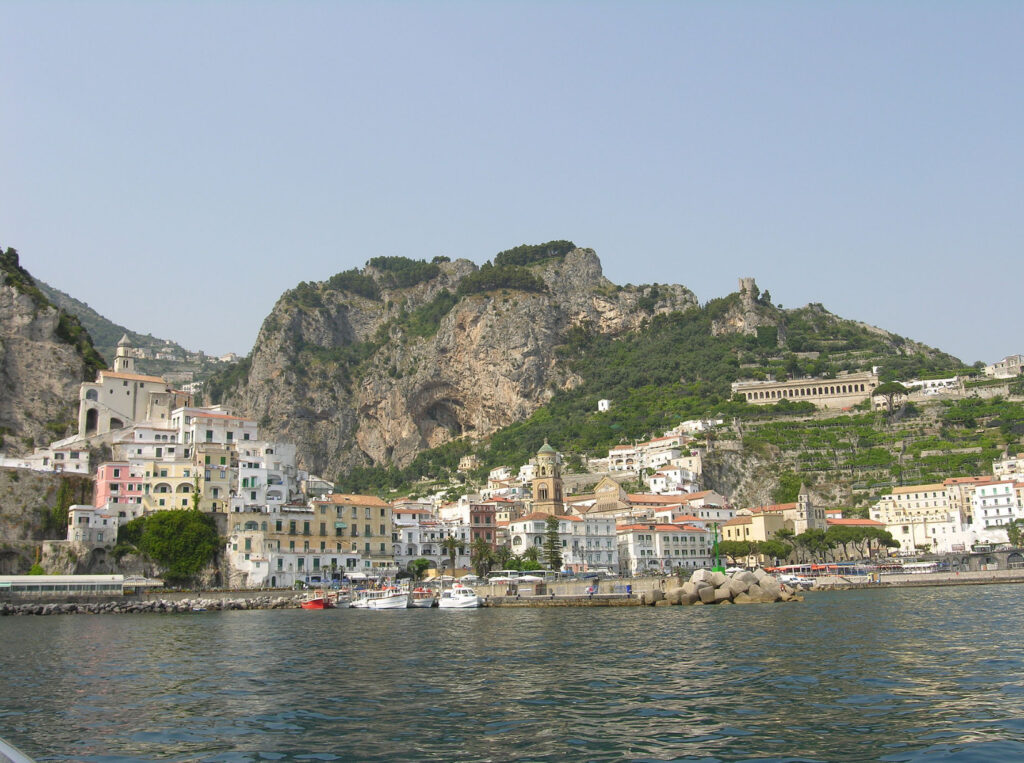
Origin and Early History
Amalfi is a historic town situated on the Gulf of Salerno in the Campania region of southern Italy. Its origins trace back to the Roman era, though it began to gain prominence in the 6th and 7th centuries AD. Initially a small fishing village, Amalfi started to develop as a significant settlement during the decline of the Western Roman Empire. Its strategic coastal location made it an ideal point for maritime trade and communication between the Eastern and Western Mediterranean.
Rise as a Maritime Republic
In the 9th century, Amalfi emerged as an independent city-state, becoming one of the first maritime republics in Italy alongside Genoa, Pisa, and Venice. Governed by its own dukes (or doges), the Duchy of Amalfi established itself as a formidable naval and trading power from the 9th to the 11th centuries.
Amalfi’s merchants were pioneers in trade with the Byzantine Empire and the Arab world. They imported luxury goods like spices, silks, and precious metals, which were then distributed throughout Europe. The town developed its own code of maritime law, the “Tabula Amalphitana,” which was widely respected and used in the Mediterranean for centuries.
Cultural and Architectural Development
During its peak, Amalfi was not just a commercial hub but also a center of culture and learning. The amalgamation of Byzantine, Arab, and Western influences is evident in its art, architecture, and literature. The construction of the Amalfi Cathedral (Duomo di Amalfi), dedicated to Saint Andrew, began in the 9th century and showcases a blend of architectural styles, including Romanesque and Arabic-Norman elements.
Decline
Amalfi’s decline began in the 11th century due to several factors:
- Norman Conquest: In 1073, the Normans, led by Robert Guiscard, conquered Amalfi, incorporating it into the Kingdom of Sicily. This reduced its independence and political influence.
- Competition: The rise of other maritime republics like Pisa, Genoa, and Venice overshadowed Amalfi’s trading dominance.
- Natural Disasters: A catastrophic earthquake and subsequent tsunami in 1343 destroyed much of the lower town and its harbor, severely crippling its maritime activities.
- Plague and Piracy: Like many Mediterranean towns, Amalfi suffered from outbreaks of the Black Plague and attacks by pirates, which further hindered its development.
Integration into Larger Kingdoms
After its decline as a maritime power, Amalfi became part of various kingdoms that ruled southern Italy, including the Kingdom of Naples and later the Kingdom of the Two Sicilies. During these periods, Amalfi shifted from being a trading powerhouse to a quiet coastal town. Its economy relied more on agriculture, fishing, and small-scale industry, such as paper-making—a craft that had been introduced during its trading zenith.
19th and 20th Century Revival
The 19th century brought renewed interest in Amalfi and the surrounding coast as part of the “Grand Tour,” a traditional trip around Europe undertaken by mainly upper-class European young men. Artists, writers, and poets were drawn to the area’s natural beauty and historical significance.
In the 20th century, especially post-World War II, Amalfi transformed into a popular tourist destination. Infrastructure improvements, such as better roads and accommodations, facilitated access for international visitors. The town capitalized on its rich history, stunning landscapes, and cultural heritage to attract tourists from around the world.
Modern Development
Today, Amalfi is part of the UNESCO-listed Amalfi Coast, recognized for its exceptional cultural and natural scenic value. The local economy thrives on tourism, with visitors drawn to its historical sites, such as the Amalfi Cathedral and the ancient arsenals, as well as its beaches and coastal scenery.
Efforts have been made to preserve its historical architecture and natural environment. The town continues to celebrate its maritime heritage through festivals and events, like the Regatta of the Ancient Maritime Republics, which commemorates the historic rivalries and achievements of Italy’s former maritime powers.
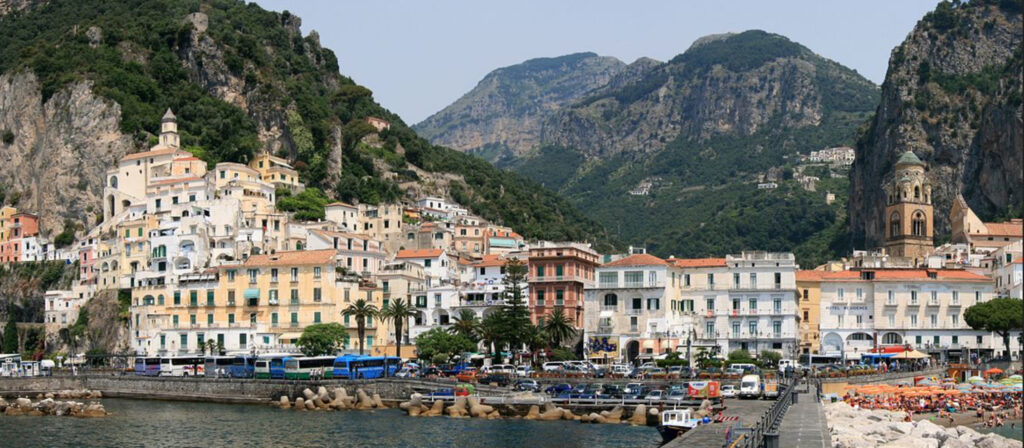
Historical Monuments and Tourist Attractions of Amalfi
Amalfi, a jewel on Italy’s southern coast, is steeped in history and natural beauty. Below is a comprehensive list of historical monuments and tourist attractions that showcase the town’s rich cultural heritage and stunning landscapes.
1. Amalfi Cathedral (Duomo di Amalfi)
- Description: A magnificent cathedral dedicated to Saint Andrew, the patron saint of Amalfi.
- Highlights:
- Architectural Styles: A blend of Romanesque, Byzantine, Gothic, and Baroque influences.
- Facade: Striking Arab-Norman style with intricate mosaics and bronze doors cast in Constantinople in 1066.
- Bell Tower: A 12th-century campanile featuring Moorish design elements.
- Crypt of Saint Andrew: Houses the relics of the apostle, brought to Amalfi in 1208.
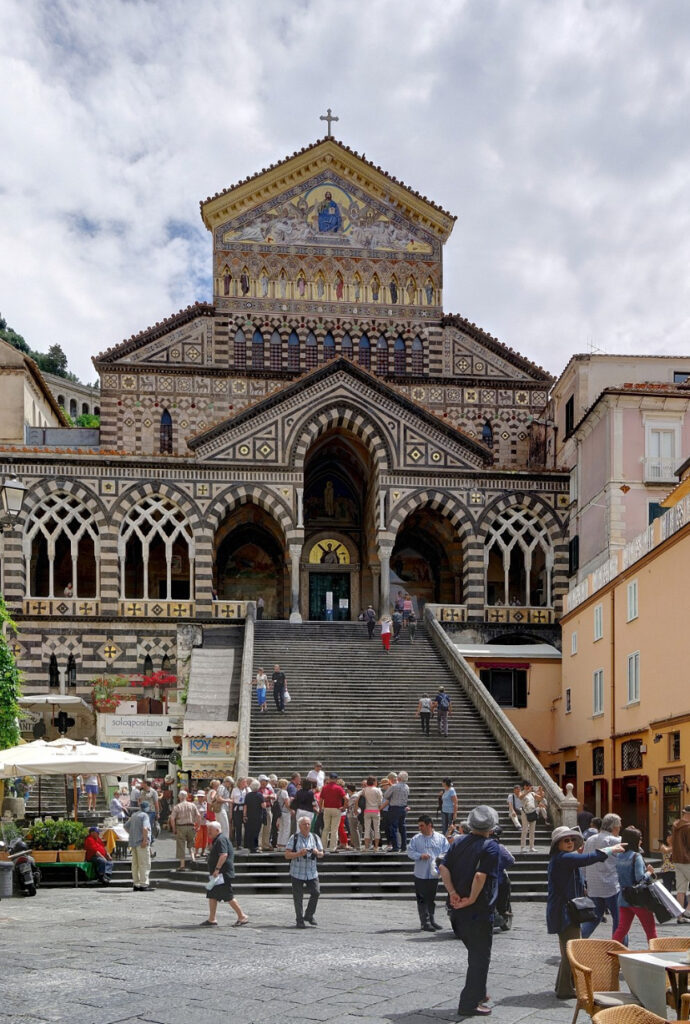
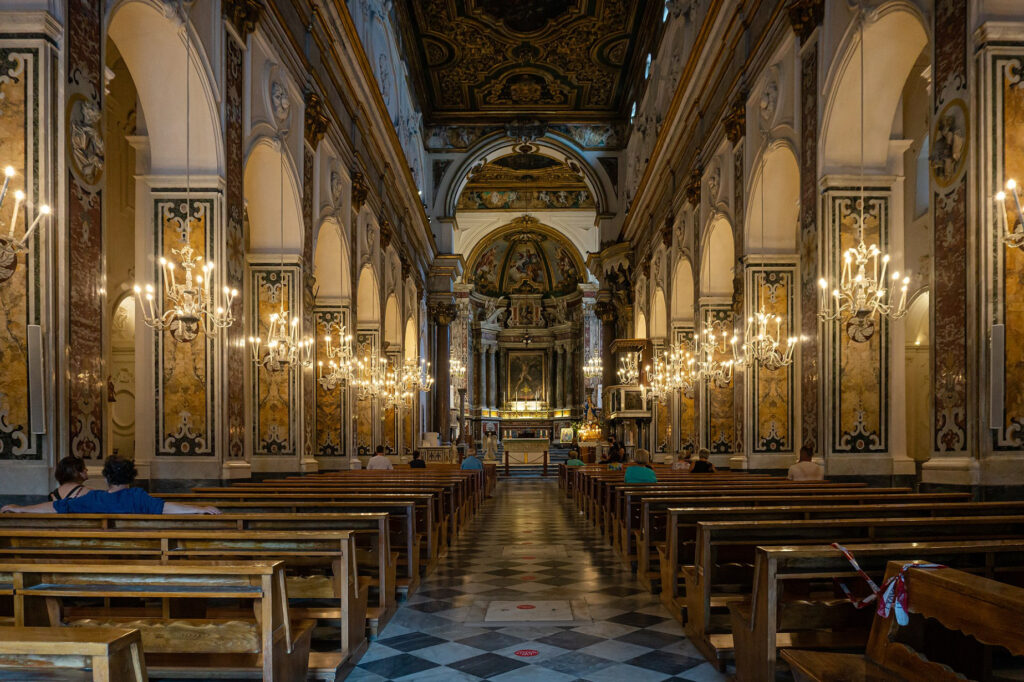
2. Cloister of Paradise (Chiostro del Paradiso)
- Description: An elegant 13th-century cloister adjacent to the cathedral.
- Highlights:
- Architecture: Features white marble columns and Moorish-style arches forming a quadrangle.
- Artifacts: Contains ancient sarcophagi, sculptures, and fragments of early Christian and medieval art.
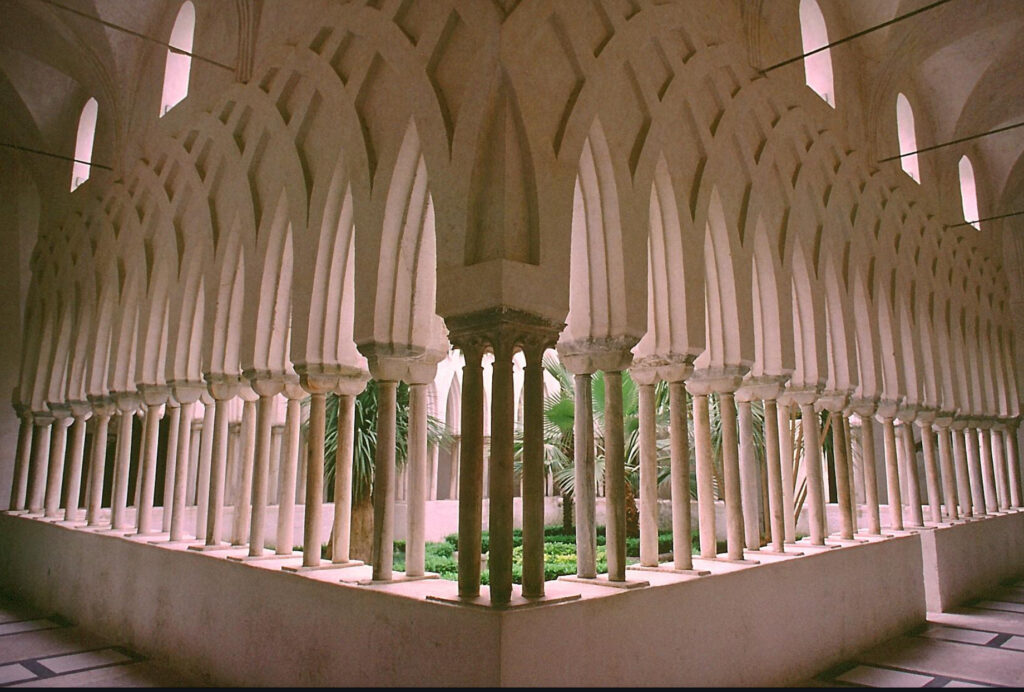
3. Museum of Handmade Paper (Museo della Carta)
- Description: Dedicated to Amalfi’s historic paper-making industry dating back to the 13th century.
- Highlights:
- Exhibits: Original machinery and tools used in traditional paper production.
- Demonstrations: Live presentations of the paper-making process.
- Historical Building: Located in an old paper mill along the Canneto River.
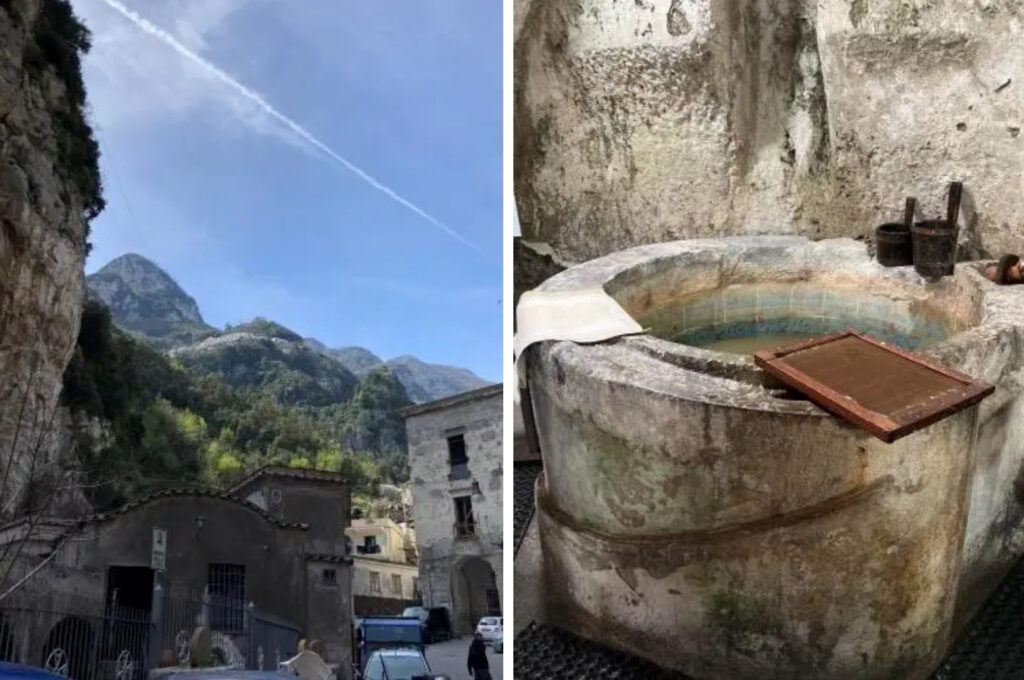
4. Ancient Arsenals of the Amalfi Republic (Antichi Arsenali della Repubblica)
- Description: The remnants of medieval shipyards from Amalfi’s time as a maritime power.
- Highlights:
- Architecture: Gothic vaults and stone arches.
- Exhibitions: Displays on maritime history, including ship models and naval artifacts.
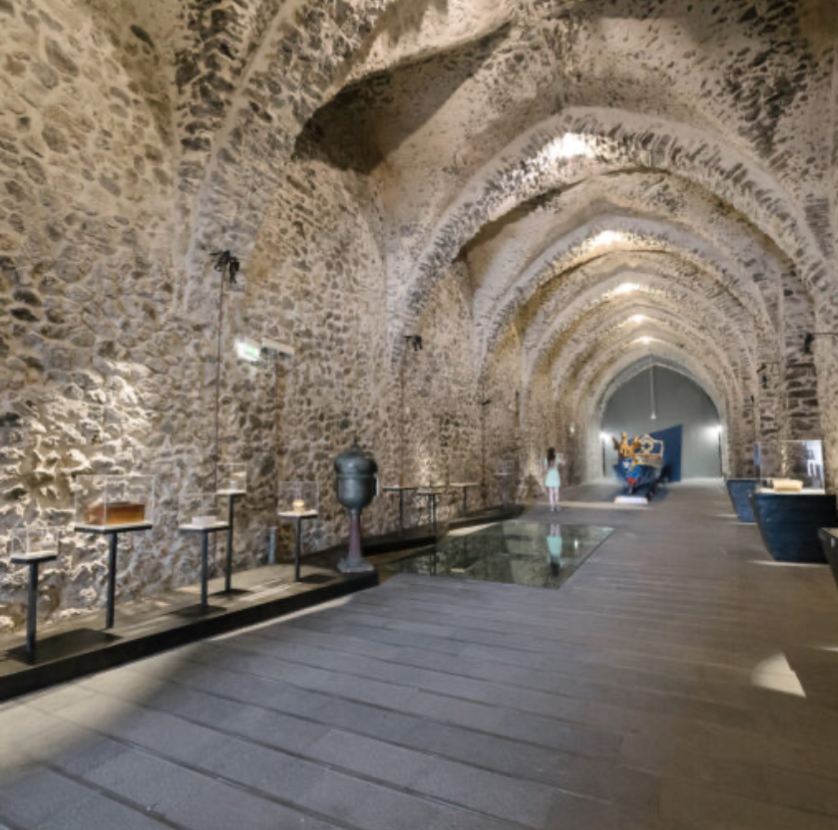
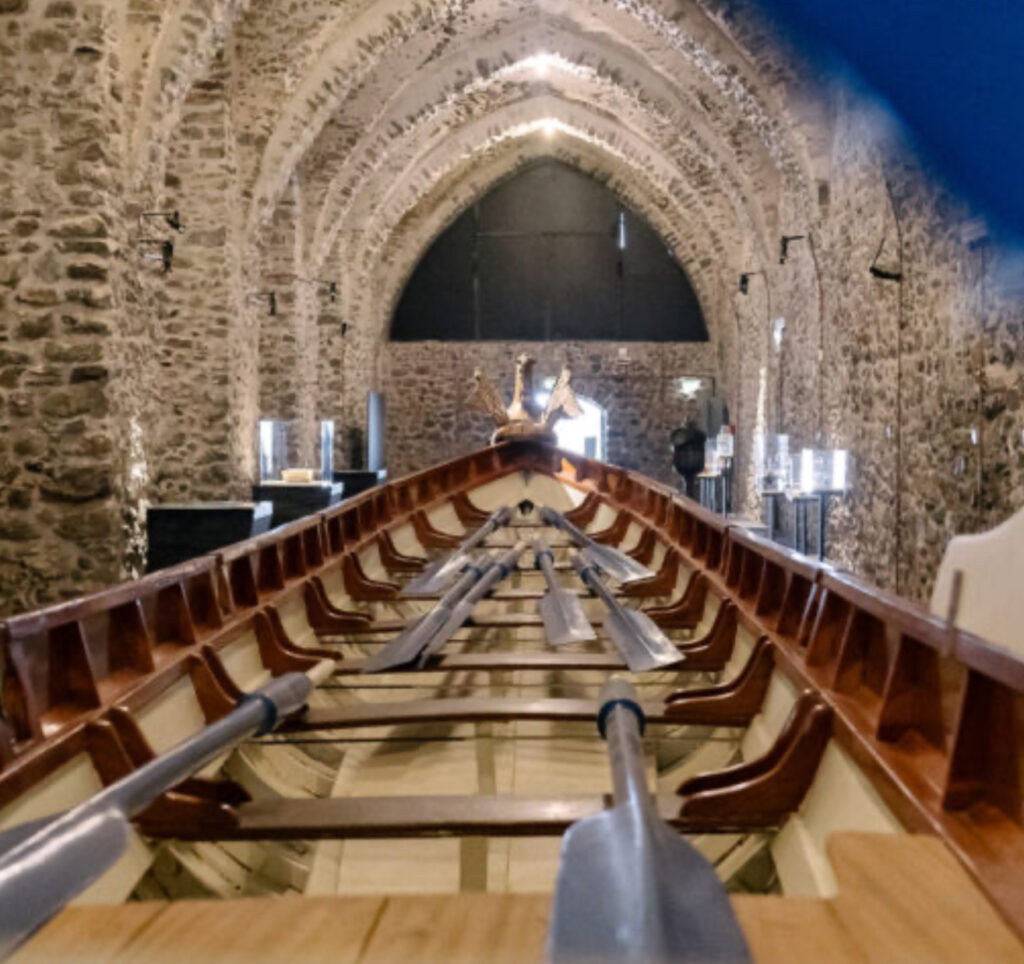
5. Valle delle Ferriere (Ferriere Valley)
- Description: A lush natural reserve ideal for hiking and nature walks.
- Highlights:
- Scenery: Waterfalls, streams, and dense vegetation, including rare fern species.
- Historical Sites: Ruins of ancient ironworks and paper mills.
- Trails: Paths suitable for various skill levels, offering serene natural beauty.
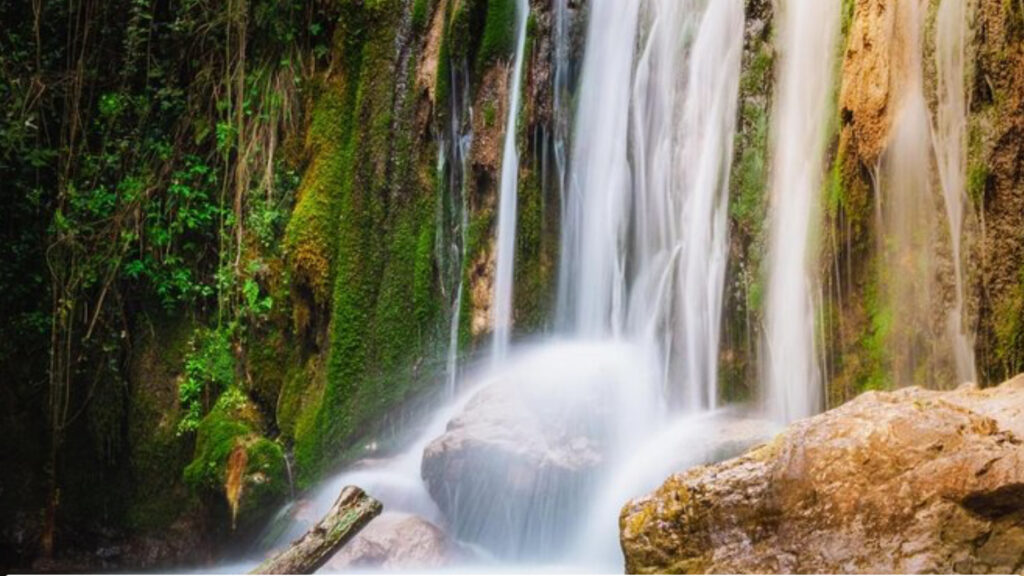
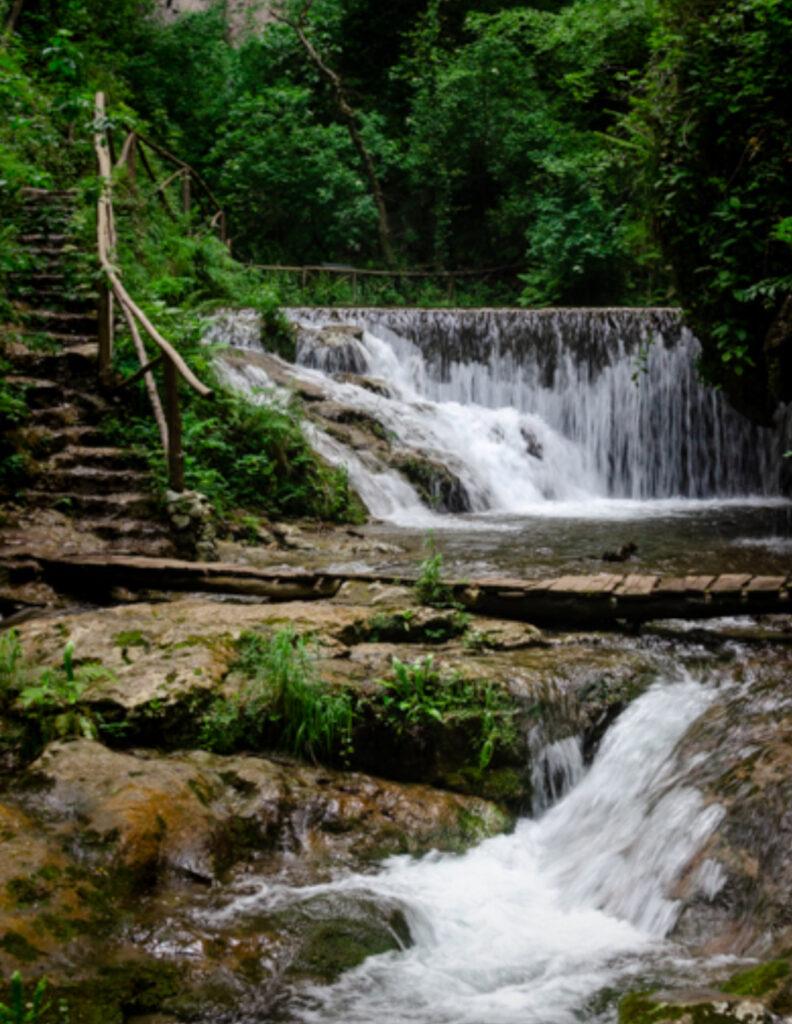
6. Torre dello Ziro
- Description: A medieval watchtower perched on a hill between Amalfi and Atrani.
- Highlights:
- Views: Panoramic vistas of the coastline and surrounding towns.
- Legends: Associated with stories of Queen Giovanna of Naples and historical intrigue.
- Access: Reachable via a hiking trail through olive groves and forests.
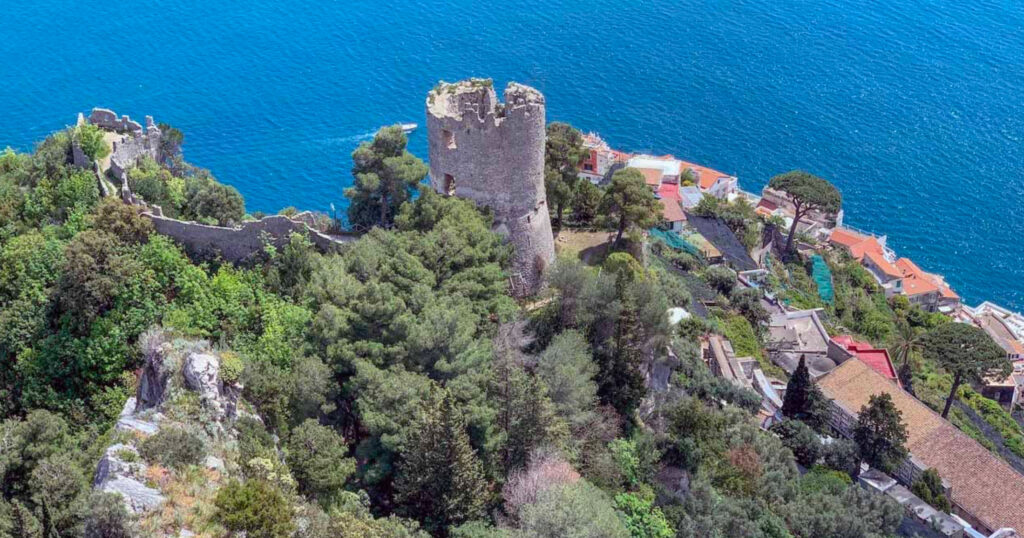
7. Grotta dello Smeraldo (Emerald Grotto)
- Description: A captivating sea cave known for its emerald-green waters.
- Highlights:
- Boat Tours: Accessible by boat from Amalfi or via an elevator from the road above.
- Unique Features: Stalactites, stalagmites, and an underwater nativity scene.
8. Piazza del Duomo
- Description: The vibrant main square in front of the cathedral.
- Highlights:
- Fountain of Saint Andrew: A Baroque fountain serving as a popular meeting point.
- Atmosphere: Surrounded by cafés, restaurants, and shops, ideal for people-watching.
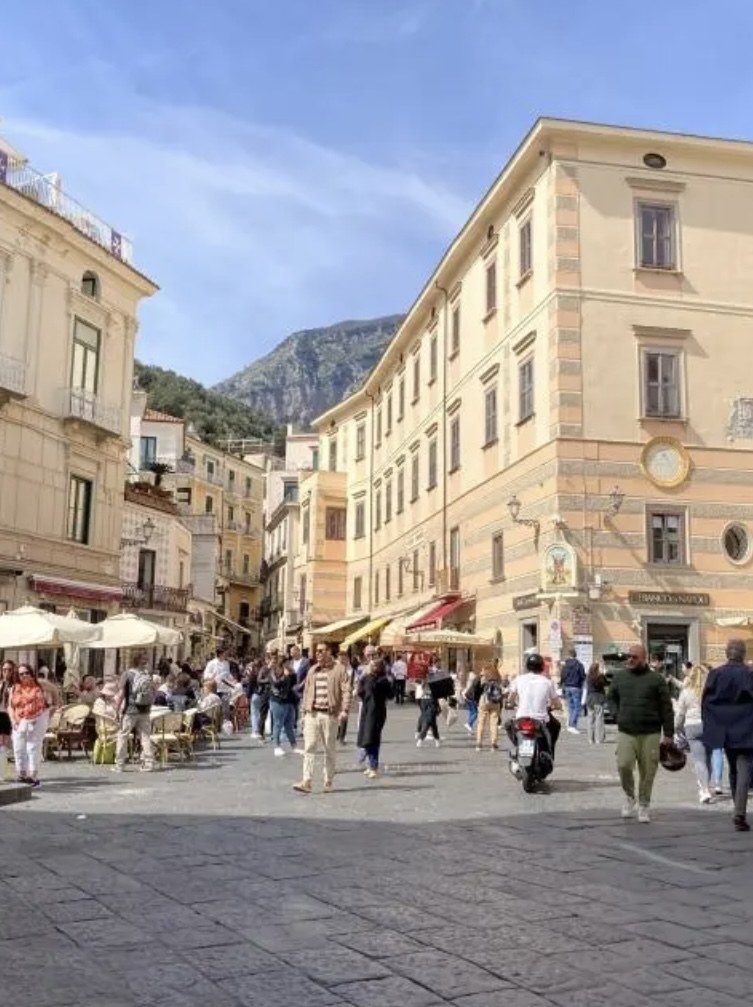
9. Beaches
- Marina Grande Beach:
- Description: The main beach area offering sunbeds, umbrellas, and eateries.
- Activities: Swimming, sunbathing, and water sports.
- Duoglio Beach:
- Description: A more secluded pebble beach accessible by stairs or boat.
- Features: Clear waters ideal for snorkeling.
10. Sentiero dei Limoni (Path of the Lemons)
- Description: A scenic walking trail connecting Amalfi to the neighboring town of Minori.
- Highlights:
- Views: Overlooks terraced lemon groves and the coastline.
- Experience: Offers insight into local agriculture and breathtaking panoramas.
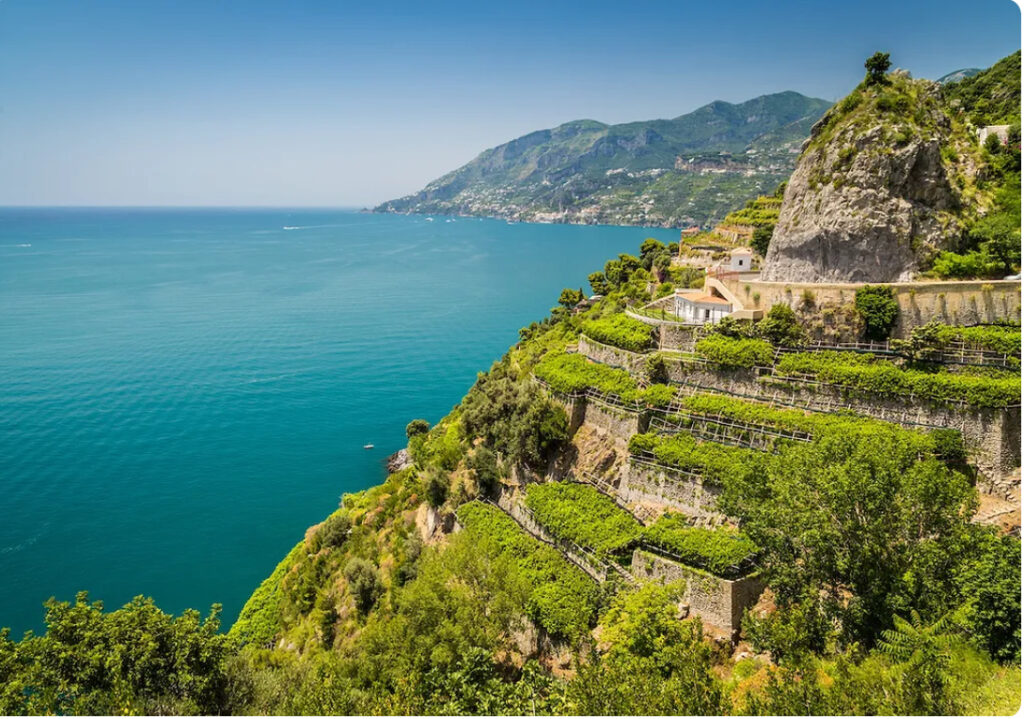
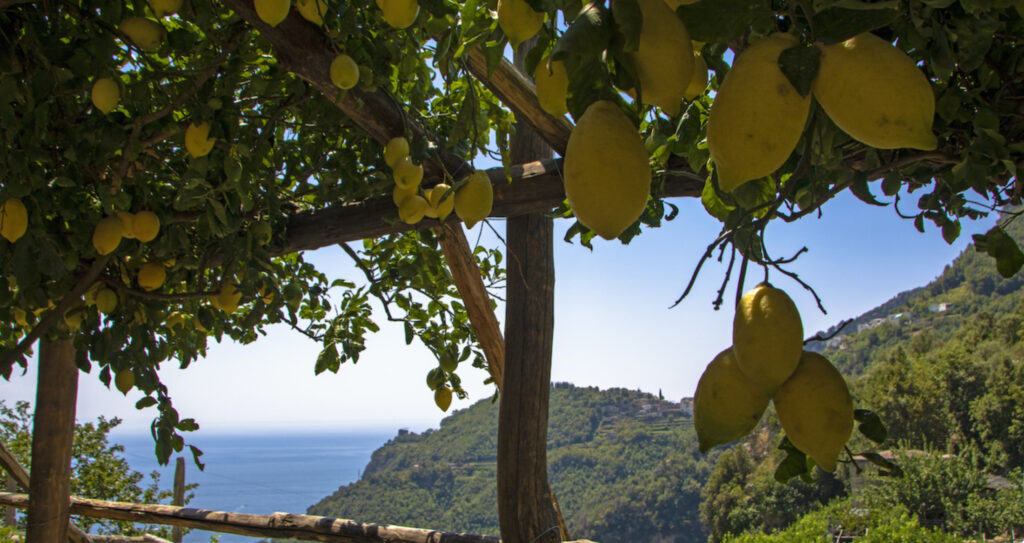
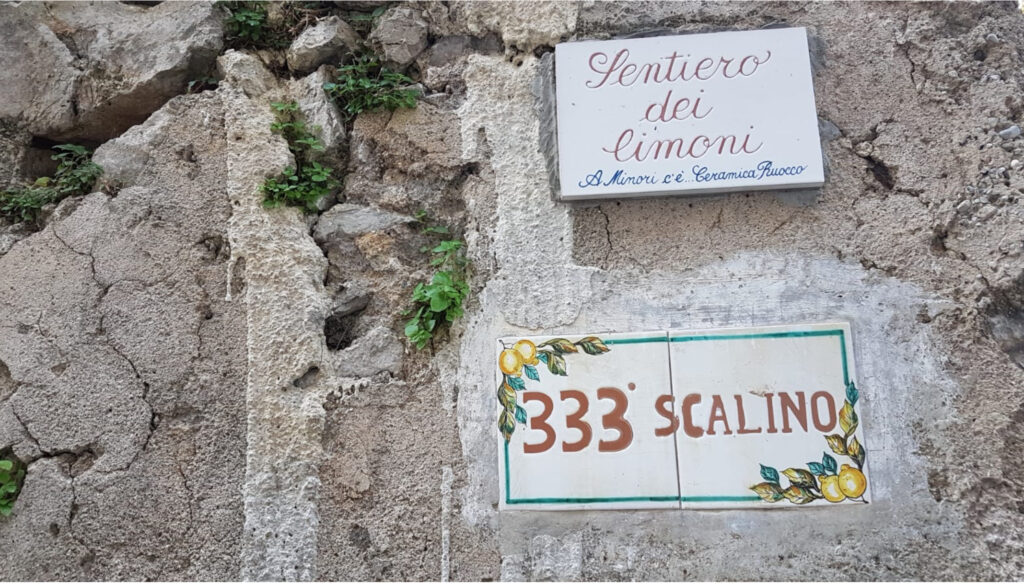
11. Local Artisan Shops
- Ceramics:
- Description: Hand-painted pottery featuring traditional Mediterranean designs.
- Locations: Various boutiques throughout the town.
- Limoncello:
- Description: Shops offering this famous lemon liqueur made from locally grown lemons.
- Tastings: Many stores provide samples of limoncello and other lemon-based products.
- Handmade Paper Products:
- Description: Stationery, journals, and art crafted from Amalfi’s renowned paper.
12. Museum of the Compass and Maritime Duchy (Museo della Bussola e del Ducato Marinaro)
- Description: Celebrates Amalfi’s maritime history and contributions to navigation.
- Highlights:
- Exhibits: Navigational instruments, including compasses and astrolabes.
- Documents: Historical records and maps from the time of the Maritime Republic.
13. Festivals and Events
- Festival of Sant’Andrea:
- Dates: June 27th and November 30th.
- Activities: Religious processions carrying the statue of Saint Andrew, fireworks, and local celebrations.
- Regatta of the Ancient Maritime Republics:
- Description: A historical boat race between Amalfi, Genoa, Pisa, and Venice.
- Features: Processions with participants in period costumes; hosted in Amalfi every four years.
14. Valle dei Mulini (Valley of the Mills)
- Description: A valley that was once the heart of Amalfi’s paper industry.
- Highlights:
- Ruins: Remnants of old paper mills dating back to the 13th century.
- Nature Walks: Trails through lush landscapes alongside the Canneto River.
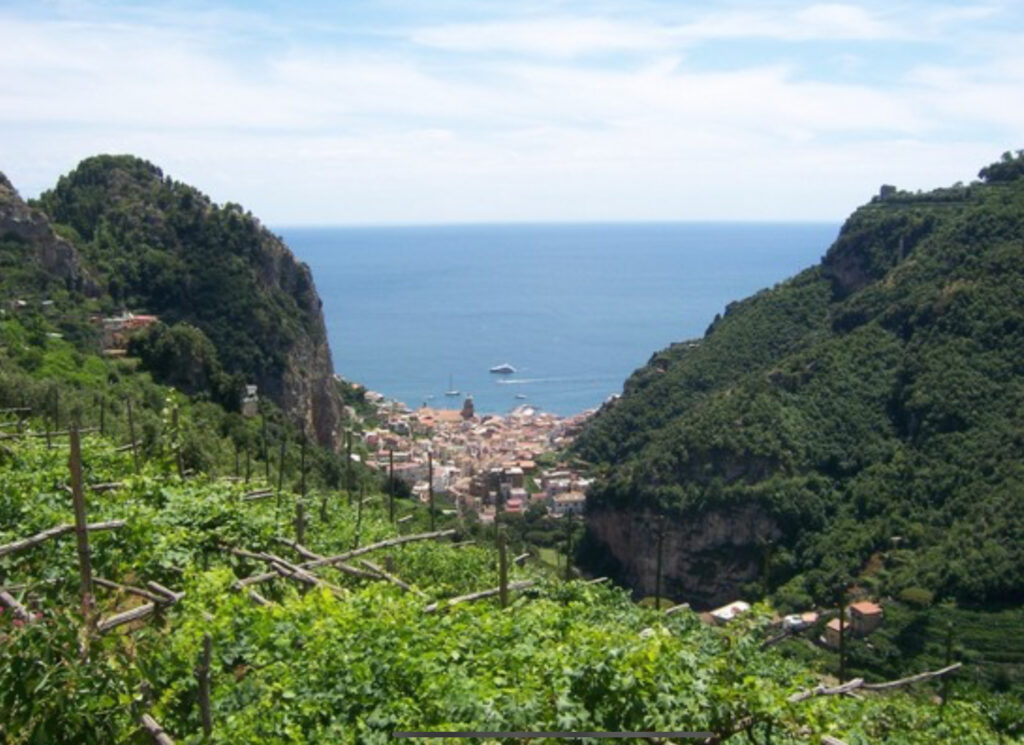
15. Churches and Chapels
- Church of Santa Maria Maggiore:
- Description: One of Amalfi’s oldest churches with beautiful frescoes and artwork.
- Sanctuary of Our Lady of Sorrows (Santuario di Santa Maria dei Dolori):
- Description: A serene chapel offering a peaceful retreat and spiritual reflection.
Visitor Tips
- Accessibility: Many attractions are within walking distance, but some require climbing stairs or hiking.
- Guided Tours: Consider hiring a local guide for in-depth historical context.
- Best Time to Visit: Late spring (April to June) and early autumn (September to October) for pleasant weather and fewer crowds.
- Local Etiquette: Dress modestly when visiting religious sites; engage respectfully with locals.
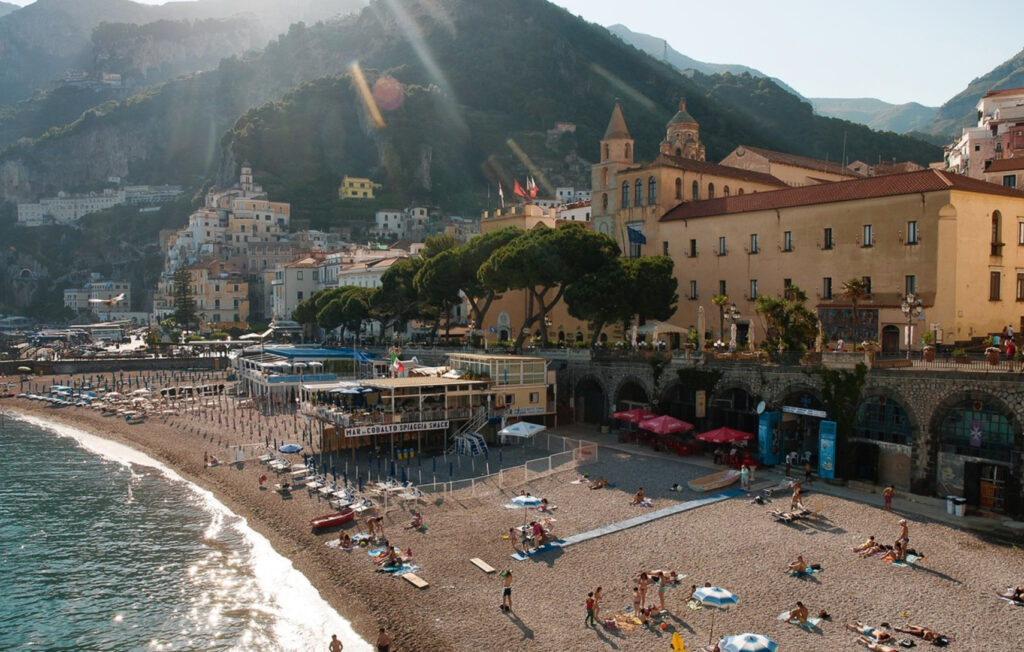
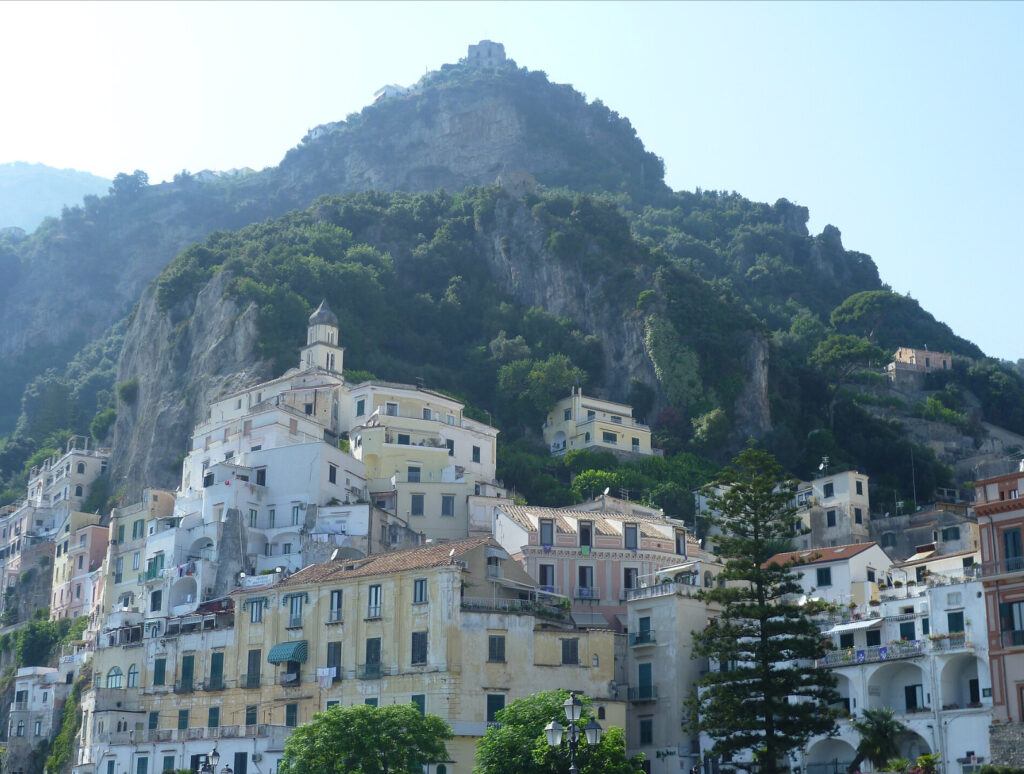
One-Day Itinerary for Visiting Amalfi
Experience the best of Amalfi with a blend of historical exploration, culinary delights, and an easy hike through lush landscapes. This itinerary is designed to maximize your day while immersing you in the local culture and natural beauty of this charming coastal town.
Morning
1. Breakfast at Pasticceria Andrea Pansa (8:00 AM – 9:00 AM)
- Location: Piazza Duomo, right next to the Amalfi Cathedral.
- Highlights:
- Start your day with a traditional Italian breakfast at this historic pastry shop established in 1830.
- Try local pastries like Sfogliatella (a shell-shaped filled pastry) or Delizia al Limone (a lemon delight dessert).
- Enjoy a rich Italian espresso or cappuccino while soaking in the morning ambiance of the piazza.
2. Explore the Amalfi Cathedral and Cloister of Paradise (9:00 AM – 10:30 AM)
- Amalfi Cathedral (Duomo di Amalfi):
- Highlights:
- Admire the stunning Arab-Norman Romanesque architecture.
- Marvel at the bronze doors cast in Constantinople in 1066.
- Visit the Crypt of Saint Andrew, housing the relics of the apostle.
- Cloister of Paradise (Chiostro del Paradiso):
- Highlights:
- Stroll through the serene 13th-century cloister with its Moorish-style arches and lush garden.
- View ancient sarcophagi and artworks reflecting Amalfi’s rich history.
3. Visit the Ancient Arsenals (10:30 AM – 11:15 AM)
- Antichi Arsenali della Repubblica:
- Highlights:
- Explore the medieval shipyards that were once the backbone of Amalfi’s naval power.
- Learn about maritime history through exhibits and restored artifacts.
Late Morning
4. Stroll Through the Town and Shopping (11:15 AM – 12:15 PM)
- Highlights:
- Wander the narrow streets lined with colorful buildings and bougainvillea.
- Visit artisan shops selling handmade ceramics, limoncello, and Amalfi’s famous paper products.
- Recommended shops:
- La Scuderia del Duca for traditional paper goods.
- Ceramiche d’Arte Carmela for hand-painted ceramics.
Lunch
5. Lunch at Trattoria da Gemma (12:30 PM – 2:00 PM)
- Location: Via Fra Gerardo Sasso, a short walk from the main square.
- Highlights:
- Enjoy authentic Amalfitan cuisine in a cozy setting.
- Recommended Dishes:
- Scialatielli ai Frutti di Mare: Homemade pasta with fresh seafood.
- Parmigiana di Melanzane: Eggplant Parmesan.
- Beverages:
- Pair your meal with a local white wine like Falanghina or Greco di Tufo.
Afternoon
6. Easy Hike in Valle delle Ferriere (2:15 PM – 5:00 PM)
- Getting There:
- The trailhead begins near the town center; follow signs for Valle delle Ferriere.
- Highlights:
- Trail Experience:
- An easy to moderate hike suitable for most fitness levels.
- The path meanders through lemon groves, chestnut forests, and alongside the Canneto River.
- Sights to See:
- Ruins of ancient paper mills and ironworks.
- A protected nature reserve with rare flora like the giant fern (Woodwardia radicans).
- Picturesque waterfalls and small cascades.
- Tips:
- Wear comfortable hiking shoes.
- Bring a reusable water bottle and stay hydrated.
- Don’t forget your camera for the stunning natural scenery.
Mid-Afternoon Refreshment
7. Lemon Granita at Andrea Pansa (5:00 PM – 5:15 PM)
- Location: Return to Piazza Duomo.
- Highlights:
- Refresh yourself with a lemon granita, a semi-frozen dessert made from Amalfi’s famous lemons.
- Alternatively, try a scoop of gelato in flavors like lemon, pistachio, or stracciatella.
Evening
8. Visit to Atrani (5:30 PM – 7:00 PM)
- Getting There:
- A scenic 10-minute walk from Amalfi along the coast or through pedestrian tunnels.
- Highlights:
- Atrani Village:
- Explore one of Italy’s smallest and most picturesque villages.
- Wander through the charming Piazza Umberto I.
- Church of San Salvatore de’ Birecto:
- Visit this historic church dating back to the 10th century.
- Sunset Views:
- Enjoy breathtaking views of the coastline as the sun sets over the Tyrrhenian Sea.
Dinner
9. Dinner at Ristorante Marina Grande (7:30 PM – 9:30 PM)
- Location: Back in Amalfi, situated along the beachfront.
- Highlights:
- Ambiance:
- Dine with a panoramic view of the sea and the illuminated coastline.
- Recommended Dishes:
- Grilled Fresh Catch of the Day: Locally sourced fish grilled to perfection.
- Risotto al Limone: Lemon-infused risotto showcasing Amalfi’s citrus heritage.
- Seafood Antipasto: A selection of marinated and grilled seafood starters.
- Dessert:
- Indulge in a Delizia al Limone or Torta Caprese (a rich chocolate and almond cake).
- Beverages:
- Try a glass of Limoncello as a digestivo after your meal.
Additional Tips
- Comfortable Attire: Wear light, breathable clothing and comfortable shoes suitable for walking and hiking.
- Sun Protection: Use sunscreen, wear a hat, and bring sunglasses, especially for the afternoon hike.
- Hydration: Carry a water bottle; there are fountains in town to refill.
- Reservations: It’s advisable to make reservations for lunch and dinner to ensure seating, particularly during peak season.
- Cash and Cards: While most places accept credit cards, some small shops and cafes may prefer cash.
- Local Etiquette:
- Greet shopkeepers with a friendly “Buongiorno” (good morning) or “Buonasera” (good evening).
- Dress modestly when visiting churches and religious sites.
Optional Activities
- Boat Tour to the Emerald Grotto:
- If time permits, consider a short boat trip to the Grotta dello Smeraldo to see the mesmerizing emerald-colored waters.
- Attend a Cultural Event:
- Check the local calendar for any festivals, concerts, or events happening during your visit.
